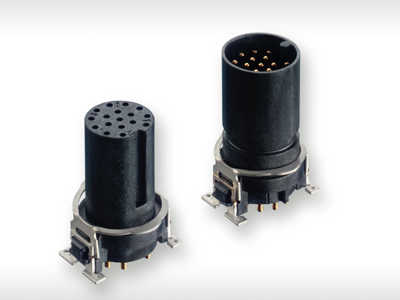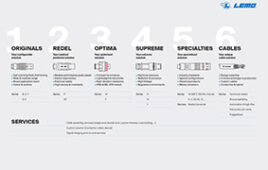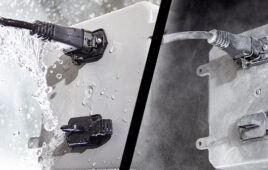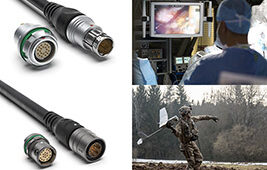Industrial Ethernet applications are growing, so your connector choices and options should as well. The M8/M12 connectors continue to evolve to meet pin density and data rates needed now.
ERNI Electronics, Inc.
Industrial Ethernet offers cost, data volume, and transmission speed improvements over other technologies, including fieldbus. Industrial Ethernet can also handle harsh environments, data collisions, factory noise and process needs. But the continued development and expansion of more complex industrial automation environments, such as Industry 4.0, require higher performance networks with connectors with more density. Bandwidth and dense connector systems once unique to networking and datacom applications are turning into standard requirements in the smart factory of today.
The standards around Ethernet have influenced the networking and datacom-application segments. Internet Protocol and IEEE 802 standards create a natural networking infrastructure for industrial applications. Standard interfaces, such as the Modular Jack I/O, dominate the traditional networking segments. But in the industrial world, in particular on the factory floor, these Modular Jack connection points may not be suitable as they are prone to damage during handling and installation.

New variations in the M12 series support Industrial Ethernet as the connector platform evolves.
For Industry 4.0 and IoT, interconnect options include new I/O choices as well as design requirements inside a system or enclosure. Application requisites include choices that support a diverse set of mechanical and electrical solutions. A well-designed network of industrial devices should direct complex operations and store sensitive data at speeds of at least 1 Gbps.
Most industrial applications feature harsh environmental conditions of some kind — signal and data interference, dust and moisture contaminants, extreme temperatures, or shock and vibration. Connectors must be hardened for these applications while minimizing effects from increased data rates and inherent noise within an industrial environment.
Balancing density and reliability
It wasn’t that long ago when standard connectors from commercial hardware applications were used in industrial process and automation equipment. However, modern industrial hardware has increased I/O requirements, data rates, mechanical robustness and packaging, requiring smaller sizes. These elements are in various connectivity points throughout the network; including passive I/O boxes, sensors, actuators and drives. Design challenges can include higher pin count requirements or better shielding that can support more demanding electrical transmissions, such as in GbE applications while continuing to support harsh environments in a mechanically proven and sealed (IP65/IP67) interface.
In the past, M8 and M12 connector variations were used primarily as machine sensor connectors. These sensors and actuators are frequently connected to a passive I/O box that supports various protocols and applications, including Ethernet. The harsh influences of the environment on these boxes make tightly sealed (IP65/IP67) connectors a necessity. As such, the M8/M12 connector systems perform well in such applications, proven and established in sensor technology. Mechanically, the M12 connector supports various protocols with coding built into the male/female mating connectors. These protocols include keying schemes for devices (sensors/actuators) and fieldbus applications, such as Profibus and EtherNetIP.

Mechanically, the M12 connector supports various protocols with coding built into the male/female mating connectors. These protocols include keying schemes for devices (sensors/actuators) and fieldbus applications, such as Profibus and EtherNetIP.
Designers can expect a migration towards density, but without compromising the mechanical performance required in industrial designs. New variations in the M12 series are supporting Industrial Ethernet and this connector platform continues to evolve. Open pin-field connector options extending up to 17 positions are one way of optimizing networking design requirements. With GbE applications, look for maximum shielding between differential pairs and improved conductivity between the panel and the board ground plane. A proper connector design and integrated components will mitigate signal integrity concerns while supporting reliability inherent is this defacto standard interface.
Finally, another way to achieve maximum density and electrical performance is in innovative SMT termination designs with strain relief features to support the most demanding of rugged applications. These SMT termination options prove beneficial not only in optimizing signal integrity and mitigating stub effects associated with traditional through-hole terminals, but they are preferred in manufacturing the host boards or passive boxes that use an M8/M12 connector system. Proven signal and shield terminations will enhance the design and provide confidence over the life of the product once installed in a factory environment.
The defacto-standard M8/M12 connector series has long been used in industrial environments. The evolution of this connector series includes coding features to service specific industrial communications applications. Newer and modern additions include density and higher pin count options. Finally, achieving longer transmission lengths even at increased data rates can now be realized with improved shielding designs and a focus on maintaining signal integrity. Industrial Ethernet applications are growing, so your connector choices and options should as well.
ERNI product families that can support your industrial applications include M8/M12, DIN41612, SMC, MicrospeedTM and MicroCon.
ERNI Electronics Inc.
www.erni.com
Filed Under: Connectors (electrical) • crimp technologies





Tell Us What You Think!